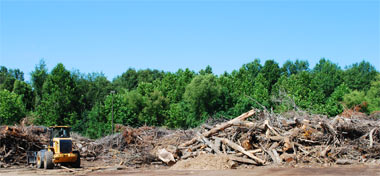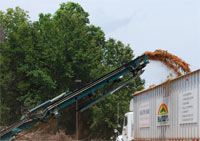
Storm reminder -- Since the May 8 windstorm, crews deposited an estimated 20,000 cubic yards of debris in the parking lot near the law school and 5,000 cubic yards in a parking lot off of Wall Street on the east side of campus. In the photo below, Hansen’s Tree Service, from O’Fallon, Mo., turns the trees and limbs into wood chips. (Photos by Chelsea Sturgeon) Download Photo Here
August 04, 2009
Storm’s destruction also creates opportunities
CARBONDALE, Ill. -- While Mother Nature certainly wreaked havoc on the Southern Illinois University Carbondale campus this past spring, she also created opportunity.
The May 8 windstorm uprooted or damaged hundreds of trees. And all of that occurred just in the main “grassy” areas of campus, not taking into account Thompson Woods and the areas surrounding campus lake.
Philip S. Gatton, director of Plant and Service Operations, believes students should play a role in discussions about tree replacement. He also sees an opportunity to perhaps create stands of various types of trees, such as dogwoods and hardwoods.
Earlier this summer, arborists with the Davey Resource Group from Kent, Ohio, performed an inventory of the grassy areas of campus.
According to the executive summary prepared for Plant and Service Operations, “Storm-damaged trees were identified by the presence of structural damage, uprooted trees, leaning trees, fresh limb or stem breakage, and hanging limbs. Stumps were identified as a result of the storm damage by the presence of disturbed root zone, freshly removed high-risk trees, or even the fallen trees lying beside them.”
Their inspection found 957 storm-damaged sites, including 573 trees and 385 stumps. That number represented 14 percent of 6,785 inventoried sites.
The arborists determined that of the 573 storm-damaged trees, 257 are in poor condition, 209 are in fair condition, 85 are deemed “critical,” 16 are in good condition, five are dead and one is in very good condition. Crews removed 177 of the trees deemed to present the most significant potential hazard.
The top five species that sustained damage in the storm were pin oak, sugar maple, eastern white pine, red maple and American sweetgum.
The inventory also provided SIUC officials with a roadmap -- literally. They have in hand GIS-generated overhead photographs of the campus showing the locations, by quadrant, of all the trees and stumps.
Gatton said the University will soon solicit bids for stump grinding, with stumps either being ground in place or taken to a lot where they will be ground into chips. He expects that process to begin about the time the new school years starts later this month.
Hansen’s Tree Service, from O’Fallon, Mo., is clearing the two lots that have served as collections points for debris -- one near the law school and the other off of Wall Street on the east side of campus. The trees are being ground into chips, which the tree service is hauling to land it is leasing in Herrin. Eventually, the firm will transport the material to Edwardsville, where it will be re-processed.
Crews removed an estimated 20,000 cubic yards of debris from campus to the law school lot, with another 5,000 cubic yards collected in the Wall Street lot.
Gatton also said the University will try to sell as many logs as possible, an environmentally sound approach designed to minimize burning.
Some grassy areas on campus sustained damage due to the heavy equipment needed to remove fallen trees. Gatton said grounds crews will re-seed those areas this fall.
That also is the best time of year for tree planting, and Gatton wants to involve students in that process, either through class projects or perhaps a focus group. He also noted that the storm altered the canopy in Thompson Woods, which in turn will alter species and growth under the canopy.
“I want to see students involved in helping to restore our tree stock,” Gatton said. “We lost a lot of trees. But this can be an opportunity for students to learn.”

